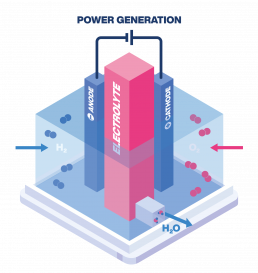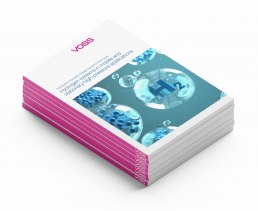As a sustainable company, we at VOSS Fluid always focus on sustainable ideas and approaches. We develop our products with this in mind, with the aim of supporting advanced types of propulsion. It is no secret that we have been devoting a great deal of attention to the topic of hydrogen for a number of years. In this blog post, we will first delve into the current state of the art.
Hydrogen-based technologies are among the most important factors when it comes to finding zero-emission alternatives in energy supply. Hydrogen is expected to continuously replace fossil fuels such as coal, oil and natural gas. Analyses show that its use in fuel cells not only reduces climate gases, but also creates new opportunities to provide fuel. At the same time, hydrogen is essential for industrial applications. As a process agent, it is an important basic material for the synthesis of chemical compounds and in reduction reactions in metallurgy. Since pure hydrogen is not a natural phenomenon, it must be produced by using energy. In this context, the differentiation of hydrogen by color has evolved.

The two most common production methods are hydrogen from hydrocarbons and hydrogen from water. Preferably, hydrogen is produced from natural gas or from long-chain hydrocarbons (gasoline). Another established process is steam reformation, in which the hydrocarbons are split in several steps under pressure and temperature with steam to form H2, CO and CO2. Electrolysis is usually the process of choice for recovery from water. In this process, water is split into hydrogen and oxygen using electricity. If the electricity comes from sustainable energy sources, it is commonly referred to as green hydrogen, for example if it is produced from wind power, water or solar parks. The concept of converting surplus electricity into hydrogen offers a particularly attractive way of making efficient use of the high availability of sustainable energy sources.
Unique challenges of hydrogen in the high-pressure range
But hydrogen can be tricky. Dealing with the gas poses a number of challenges. First and foremost, the technical requirements for systems for processing hydrogen are very high, as the pressures and temperatures utilized put great stress on the deployed materials. Because of its small molecular size, hydrogen quickly leads to embrittlement of the material in metals. The inherent flammability of the gas is also a challenge, which is why correspondingly high safety standards must be upheld. Compared to the leakage of oil, for example, gas leaks are usually only detected after it’s too late. This makes suitable connection technology among the hydrogen lines all the more important. Especially in high-pressure applications (up to approx. 700 bar), solutions are required that can withstand this pressure in the truest sense of the word. This is precisely where our challenge lies in applications with hydrogen. For our connection solutions, it is essential to avoid even small amounts of leakage. And the fact that hydrogen is the smallest molecule in the world does not make things any easier. But this also becomes a problem in the low-pressure range (up to 100 bar), where plastics, for example, are too permeable. That's why steel lines are recommended, which are standard in the high-pressure range anyway, but of course also more expensive. But the investment is worthwhile here: With classic stainless steel, many problems are ruled out right from the start.
Tube forming withstands any pressure
In the search for a reliable solution to these challenges, we decided on a new approach: a tube forming process in which a sealing and retaining contour is formed onto the end of the tube. The result is our well-known VOSS Lok 40 system. It facilitates an economically optimized, compact and permanently secure connection of tubes in hydrogen applications - both in the high-pressure and low-pressure ranges. This results, on the one hand, from the interaction of tube contour and coupling socket and, on the other hand, from the assembly reliability of the system. The specially designed, mechanized forming process with short cycle times leads to reliable preassembly and virtually eliminates errors.
Summary
In summary, the technical requirements for systems designed to process hydrogen are high. But it is worth the effort. Hydrogen is undoubtedly an energy carrier of the future, with which we at VOSS will continue to conduct a great deal of research - and thus meet the global challenge of climate change.
Would you like to learn more about hydrogen applications and the state of the art ?
Please feel free to download our free whitepaper
„The World in Transition: Energy Carriers of the Future. Hydrogen systems in mobile and stationary high-pressure applications“.
